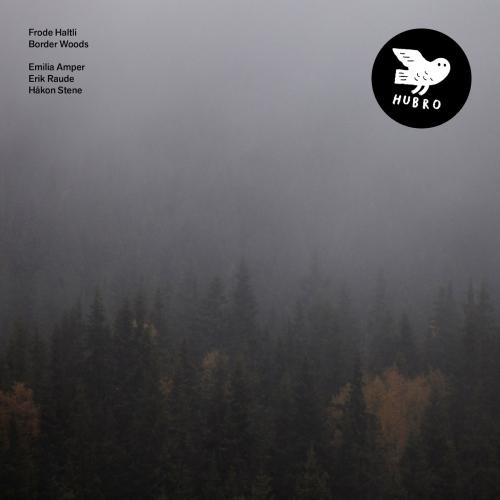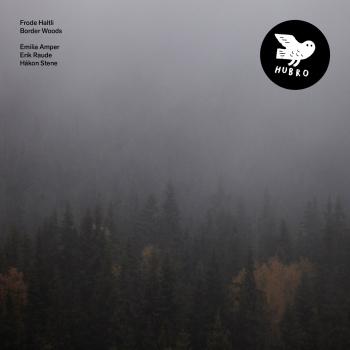
Border Woods Frode Haltli
Album info
Album-Release:
2019
HRA-Release:
10.10.2019
Album including Album cover
- 1 Wind Through Aspen Leaves 04:01
- 2 Mostamägg Polska 15:41
- 3 Wood and Stone 02:05
- 4 Taneli’s Lament (Sorrow Comes To All…) 03:47
- 5 Valkola Schottis 11:05
- 6 Quietly the Language Dies 06:27
Info for Border Woods
Accordionist and composer Frode Haltli follows up last year’s acclaimed Hubro release, ‘Avant Folk’, with a smaller-scale yet equally inspired album that is built once again on the combination of traditional Nordic folk forms with influences drawn from world music and contemporary composition/improvisation. In some ways, ‘Border Woods’ is both folkier and more ‘avant’ than its predecessor. The reduction in the size of the ensemble, from a dectet to a quartet, creates a corresponding increase in intensity, while Haltli frequently divides the unit further, using the two matched pairs of performers separately for a number of duo sequences. As the band expands and contracts in response to the demands of each tune, the music veers from cool, meditative explorations at the outer reaches of sound, to full-on pentatonic grooves and folk-rocky, foot-tapping jams.
And what a band it is. Alongside Frode Haltli on accordion, Emilia Amper on nyckelharpa (Sweden’s national instrument, a centuries-old chordophone, or keyed fiddle) makes for a perfect partnership. The two instruments are so alike in timbre that when played in unison it is often difficult to tell which is which or who is who, while the resonance of the nyckelharpa’s sympathetic strings can make it sound uncannily like a Hardanger fiddle. To confuse things further, Haltli’s accordion can so skilfully imitate the characteristics of a fiddle that, when heard in chorus, the instrumental voices recall a mini string-section. Conversely, they can sound like two accordions, too. Both instrumentalists are virtuosi who routinely work across different genres. Frode Haltli, who has recorded for ECM as well as Hubro, has been playing accordion since early childhood, while Emilia Amper, who comes from Torsas in South east Sweden, is another prodigy, who began the nyckelharpa at age ten. In 2011 she was voted “world champion” of her instrument. ‘In Folk Style’ (2L), the album she recorded with Trondheim Soloists and Gjermund Larsen in 2010, won the Norwegian Spellemannspris and was nominated for two Grammys.
Alongside the two-pronged, front-line attack of the traditional folk instruments played by Frode Haltli and Emilia Amper, Hakon Stene and Eirik Raude provide far more than the colour and ‘flavouring’ that a percussionist’s role is sometimes reduced to. They are also significant leaders and musical personalities in their own right: Hakon Stene is a Hubro solo artist (with the highly praised ‘Lush Laments for Lazy Mammal’), as well as with the influential percussion group asamisimasa, with whom he won a Spellemannspris; Eirik Raude has been a resident percussionist with the Oslo Philharmonic, and guest soloist with Berlin Philharmonic and Los Angeles Symphony Orchestra, as well as collaborating with leading improvisers including Arve Henriksen.
Playing different yet complementary kits that include mallet instruments (vibraphone, marimba), tuned and untuned drums, plus various objects to be banged or shaken, Stene and Raude in many ways determine the overall shape and character of the album. You could even say that ‘Border Woods’ begins and ends with them. Although all six compositions are written by Frode Haltli, the opening track, ‘Wind Through Aspen Leaves’, emerges very slowly out of an atmospheric rumble of cymbals, while in the closing piece, ‘Quietly the Language Dies’, each percussionist plays six tuned wine glasses to produce an eerie, glass harmonica drone. Bookended as it is by these two avowedly experimental-sounding pieces, ‘Border Woods’ definitely becomes far more ‘avant’ than ‘folk’.
“The percussionists played on glasses tuned in quarter-tones, while Emilia played a quarter-tone tuned tenor nyckelharpa, and I used a quarter-toned tuned accordion”, says Frode Haltli of ‘Quietly the Language Dies’. “It’s the same instrument I used on the track ‘Kingo’ on ‘Avant Folk’. I had it tuned in Cairo years ago, with some notes tuned to Arabic scales. The fun thing is that it fits so well with Emilia’s harp, where some notes are tuned in quarter-tones too, but intended for Scandinavian traditional music. The result is some archaic sounding music from who knows where!”
If ‘Border Woods’ begins and ends with experimental soundscaping, the middle sections contain some of the most joyfully rocking and riffing, folk-based grooves imaginable. Accordion and nyckelharpa are locked into a symbiotic partnership where it’s impossible to tell who is leading and who is following. The initiative seems to swap so quickly from instrument to instrument, and from what sounds like a sea shanty, to a jig or reel, to a snatch of what could be French cafe music or a minimalist piece by Steve Reich, that it’s impossible to keep count. Meanwhile, the percussionists do their thing, sometimes complementing, sometimes appearing to undercut or work against the text, inserting an essential element of unpredictability.
This sense of unpredictability is something that Frode Haltli has remarked upon. “I listened through the whole master-tape the other day, realising that it is probably very difficult to categorise this music for new listeners”, he admits. “But I like it!”
Frode Haltli, accordion
Emilia Amper, nyckelharpa
Håkon Stene, percussion
Eirik Raude, percussion
Frode Haltli
(b. 1975, Norway) began playing the accordion at the age of seven. As a child he played folk music but soon moved into different forms. Playing music by composers such as Pietr Fiala, Per Nørgård, Arne Nordheim as well as classical music, he swiftly developed exceptional instrumental skills alongside a deep understanding of new music.
In his early years he won numerous national contests, raising interest in and appreciation of the accordion to unprecedented heights. Haltli studied at the Norwegian State Academy of Music, then at the Royal Danish Music Conservatory in Copenhagen, graduating in 2000. In 2001 the Norwegian Concert Institute named him Young Soloist Of The Year, he was also placed second in the International Gaudeamus Interpreters Competition 1999 in the Netherlands.
Concerts throughout Europe as well as several other parts of the world, including the USA, Canada and Asia, raised awareness still further. Directing his career into explorations of new music, he became associated with like-minded musicians mainly in Europe where the development of adventurous forms has grown throughout recent years.
Haltli has established links with several composers, notably Maja Solveig Kjelstrup Ratkje who is one of several who have written especially for him; others include Bent Sørensen, Rolf Wallin, Atli Ingólfsson, Hans Abrahamsen, Jo Kondo and Sam Hayden. He has also worked as a composer himself, making music for theatre plays, the commissioned work ‘The Border Woods’ (Osa Festival 2015), and together with Maja S.K. Ratkje he composed the music for Elifriede Jelinek’s ‘NEID’ (Bayerischer Rundfunk 2011).
Haltli has a broad repertoire of contemporary classical works, including several concertos for the accordion, appearing with string orchestras, sinfoniettas and symphonic orchestras world wide. He has also cooperated with several string quartets.
His debut CD ‘Looking on Darkness’ was released on the prestiguos German record label ECM in 2002. It was very well recieved, Hilary Finch in the BBC Music Magazine wrote: ‘Still in his twenties, the young Norwegian accordionist Frode Haltli is clearly a performer of comparable gifts and imagination, whose astonishing virtuosity has inspired many Scandinavian composers. This debut solo presents five challenging new works which explore the furthest sonic regions of the instrument.’
Haltli released ‘Arne Nordheim Complete Accordion Works’ (Simax 2012) to great critical acclaim, followed by ‘Vagabonde Blu’ (Hubro 2014), a live solo recording from the Emanuel Vigeland Mausoleum featuring works by Salvatore Sciarrino, Aldo Clementi and Arne Nordheim. On the album ‘Air’ (ECM 2016) he recorded music for accordion and strings by Hans Abrahamsen and Bent Sørensen with the Arditti Quartet and the Trondheim Soloists.
Since 1999 he has played regularly with the trio POING, alongside saxophonist Rolf-Erik Nystrøm and double bass player Håkon Thelin. They have commissioned close to a 100 works from composers all over the world and recorded several albums.
Trygve Seim has been an important associate of Haltli since he joined Seim’s large ensemble in 2000 and made contributions to the records ‘The Source and Different Cikadas’ (2002) and ‘Sangam’ (ECM 2004). Since the release of their duo album “Yeraz” (ECM 2008) they have toured frequently together in a duo format, but also with Seim’s quartet ‘Rumi Songs’ (ECM 2016) and in other combinations.
Frode Haltli has developed several transcultural music projects, in India, China, Japan, North Korea, Egypt. He has also played music rooted in Norwegian traditional music, notably with RUSK in which he is teamed with singer Unni Løvlid and violinist Vegar Vårdal.
On his 2007 recording ’Passing Images’ (ECM), Haltli is joined by trumpeter Arve Henriksen, viola player Garth Knox, and vocalist Maja Solveig Kjelstrup Ratkje, for a selection of lyrical explorations of folk themes couched in the form of contemporary improvised music.
This theme and combination of old and new music is further delevoped in duo with Norwegian violinist Gjermund Larsen, in The Snowflake Trio with Irish flute player Nuala Kennedy and Norwegian fiddler Vegar Vårdal, as well as in a trio with fiddle player Ragnhild Furebotten and the Swedish nyckelharpa player Emilia Amper.
Frode Haltli has held master classes at music academies in Copenhagen, Oslo, Graz, Lucerne, Lodz and at at number of festivals. From 2011 to 2017 he was teaching accordion at the Norwegian Academy of Music in Oslo, but is today a full-time freelance musicians and composer based in Svartskog, Norway.
This album contains no booklet.







